Click on each costume to learn a bit about the bunads of Norway!
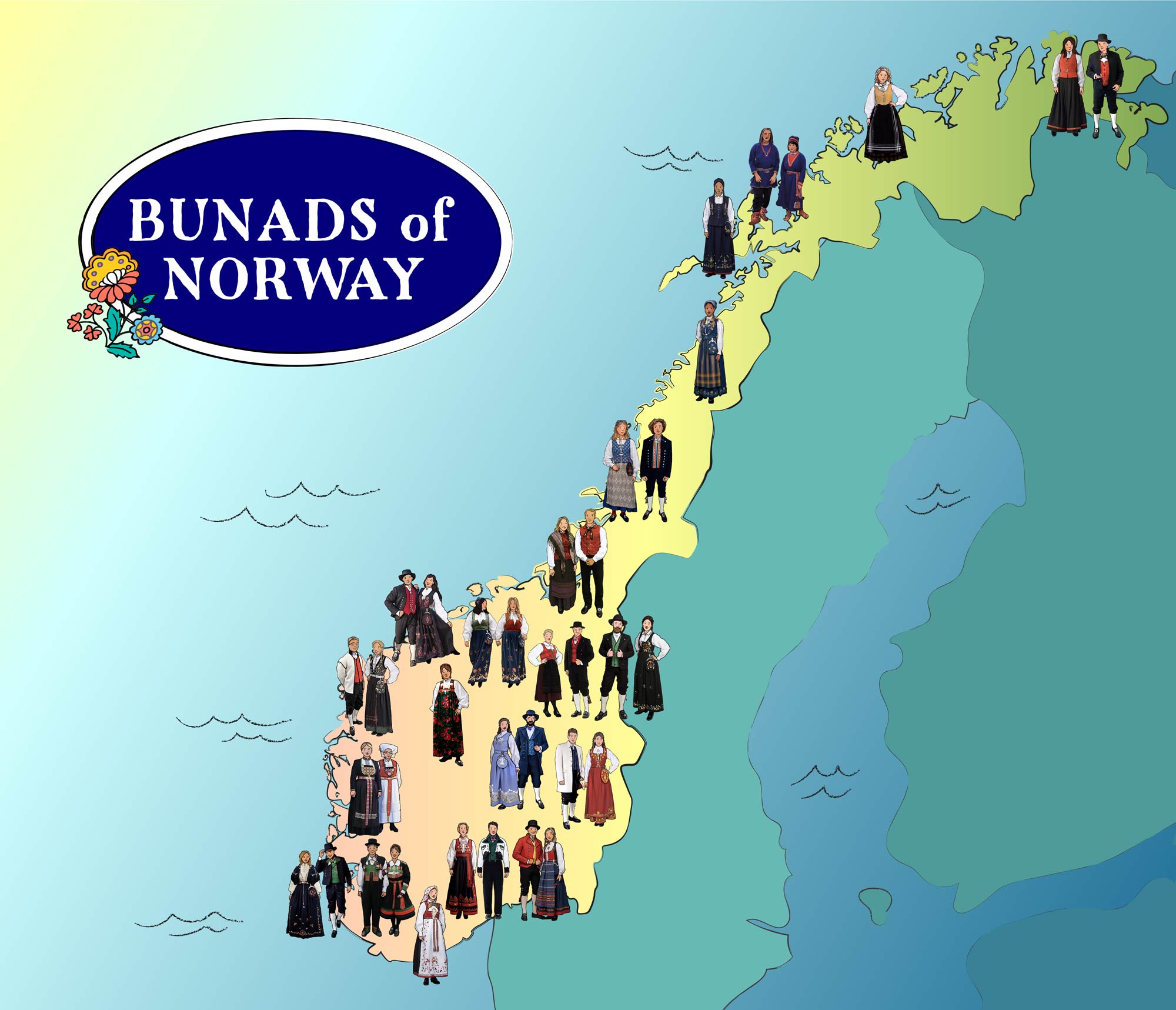
Finnmark
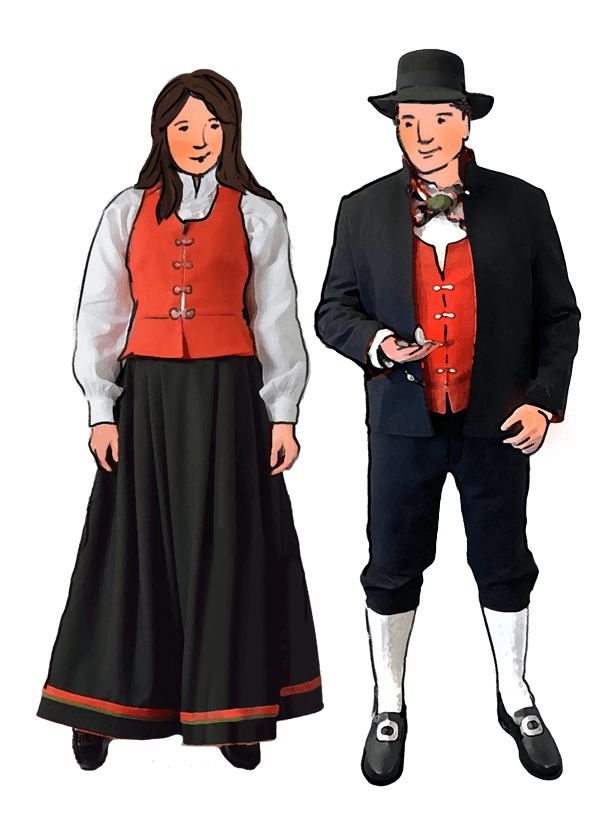
Women – Category 5
While the colors and fabric of this bunad are based on 1700s clothing from the Loppa-Vadsø area, the bunad itself was created between 1950 and 1967. Historical costumes were destroyed when Finnmark was burned at the end of World War II, so this bunad was reconstructed with the help of written sources.
The red wool bodice features a deep neckline and a peplum waist with gathers in the back that give the bodice a bell-shape. The bodice closure consists of three ornate silver clasps and one large one at the waist. The blouse is of white or antique white linen, with an embroidered collar and cuffs. The skirt is either navy or black wool, with wide pleats and stripes of red and green along the hemline. An optional wool cap and cape matches the skirt color. The streamlined bunad silver for both bunads is unique to Finnmark, with a matte finish and simple circular and square shapes, modeled by Iver Jåks after bronze jewelry found on Årøy in the Altafjord. A piece of jewelry unique to the region is a chain with pendants that attaches to the vest at each shoulder
Men – Category 5
With a quarter of its population being indigenous Sámi, the area of Finnmark has many Sámi costume traditions, but only one Norwegian bunad. The men’s sleek bunad design mirrors the women’s in almost all facets. The red wool vest has an oval neckline and is fastened with four silver clasps. The trousers can be either black wool nikkers (knickers) edged with red piping and silver buttons at the knee or long black pants. The socks are a cable knit in a natural white wool color and held up with woven strømpeband,/hosebånd (sock bands), a daily clothing staple dating back to the early Middle Ages. Even after more elastic socks designs were created, this once practical clothing piece remained to add a pop of color. These ties can be loom woven, braided, or finger woven. A multicolored silk scarf may be tied at the collar, below a silver pin. The men’s jacket is black wool with red piped edges and like the women’s bunad, has a silver closure with a chain connecting the two sides.
Sources:
Lule Sámi
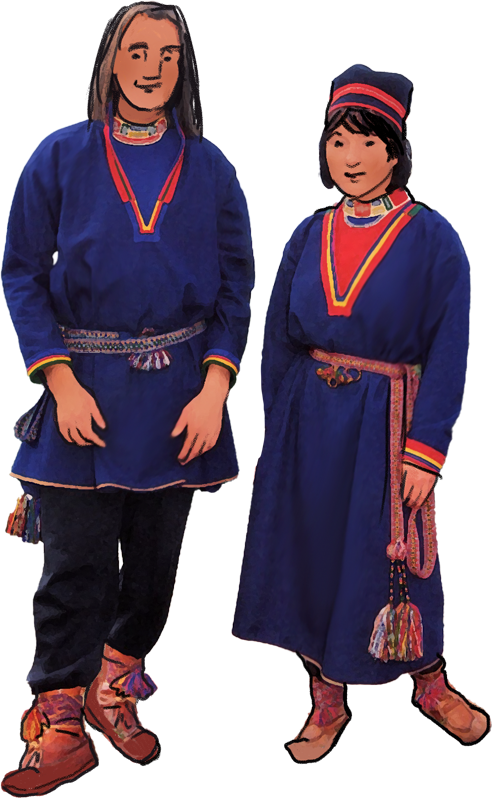
Tysfjord/Divtasvuodna Area Women & Men
The Sámi gákti, called gáppte/gábdde in the Lule Sámi language of northern Nordland county, is more of a functional garment and was not created to serve as formal clothes as bunads were. As such, it is not technically a bunad with a category rating. Much like bunads, there are gákti from each region of Sápmi, the traditional territory of the Sámi people.
The gáppte consists of a wool chemise for women and a tunic for men, woven belt, bodice or scarf, pants, cap, jewelry and leather shoes. Accessories such as a cloak, shawl, leather mittens and whip may also be added.
The garment is extremely functional, lending itself to comfort while working in cold and wet conditions. At the same time, it features aesthetic embellishments such as multi-colored edging stripes, tassels, woven wire jewelry, embroidery and applique designs. Pants or even the chemise may also be made of leather rather than wool.
Historical descriptions of Sami costumes have been made as early as 98 C.E. when the roman Tacitus described people wearing leather clothing who walked on wooden planks. Also in the years 700 and 1555, the Sami were chronicled by monk historians as wearing tunics of leather.
Sources:
Troms
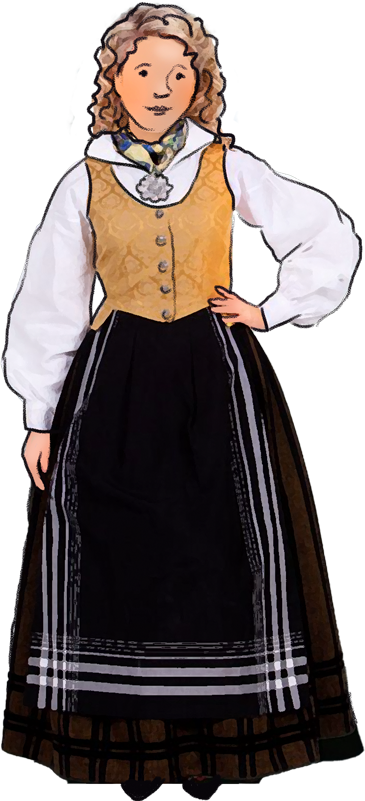
Women – Category 4
Between 1967 and 1973, the Troms Ungdomsfylking of Norges Ungdomslag researched and crafted this bunad. The requirements were that it needed to be rooted in garments from Troms. The area’s strong weaving tradition is showcased in this costume.
For the bodice, red or golden silk damask was chosen based on preserved clothing found in the Tromsø Museum. The bodice features silver buttons. A scrap of woven material was the source of the skirt fabric, made of vertical black and gold stripes with two black velvet bands running parallel to the hem.
For the black apron, edged with both vertical and horizontal white stripes, inspiration came in the form of an 1800s photo from Dyrøya. There are two hat options, both of black silk with white lace trim.
The bunad is complete with a silk scarf tied at the neck and a silver brooch.
Sources:
Lofoten

Women – Category 5
The Lofotbunad is a departure from other bunad traditions. Rather than looking to regional textile archives as the sole source of inspiration, this one was created by local teacher Arnolda Dahl in 1942 in cooperation with the local husflidslag in Hol, Nordland. Edvarda Lie designed the wildflower embroideries, which were initially rejected by the national bunad committee for being too much of a departure from the traditional look, but they were eventually approved in 1948.
The bodice is dark blue wool with rust red edging along the square neckline and the arm openings.
Wildflower embroidery embellishes both the front and back of the bodice. The skirt is also dark blue wool and has a rust red border along the hem. The whole skirt has a tall band of wildflowers starting at the hem. The linen blouse has a standing collar, with white embroidery on the color and cuffs. The bunad silver includes a filigree heart sølje blouse closure, and cufflinks for the sleeves.
Source:
Nordland

Women – Category 5
This bunad is loosely based on textiles found in Vefsn, Nordland. It was compiled by a committee from 1926 to 1928 who thought that ornamental embroidery would clearly indicate the regional background of the garment. An embroidery teacher from Vefsn, Anna Svare, created the stylized carnation pattern, as well as the scarf and apron.
The Nordlandsbunad comes in blue and green variants, and there is a myth that says that coastal nordlendinger should wear blue, and inland dwellers the green bunad, but there is no proof behind this association. The bodice has silver clasps and embroidery appears both on the front and back. The skirt has a narrow border of flowers. This bunad’s blouse is of white linen, and embroidered with hvitsøm or white embroidery along the collar and cuffs, matching the rest of the floral motifs. The jewelry includes a sølje pin at the neckline and silver cufflinks. The striped pattern of the woven apron and matching shawl is based on a silk apron from Hattfjelldal. The puffy cap, traditionally for married women, is same color as the skirt, with white lace trim.
Sources:
Trøndelag
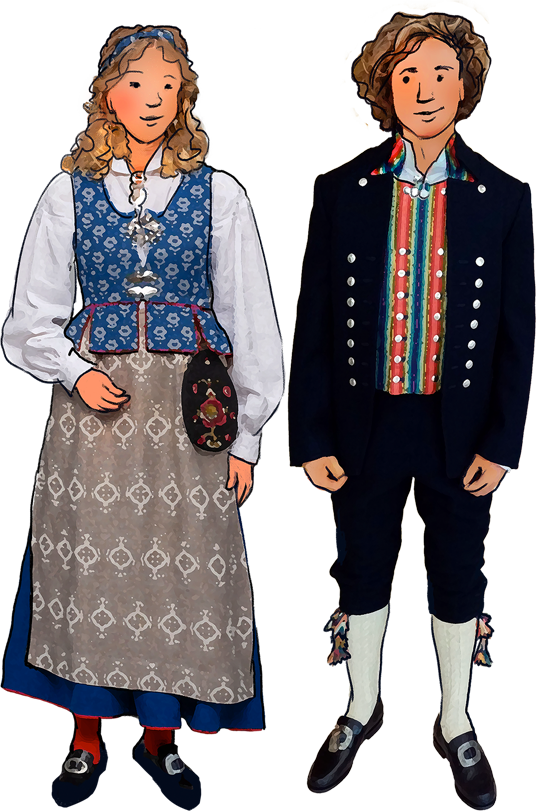
Women & Men – Category 4
Starting with some preserved textile swatches, three teachers put their heads together in the early 1920s to develop a bunad for Trøndelag. Rather than continue making bunads from the Hallingdal region, they set out to put together their own, incorporating local materials. Ragna Rytter, Kaspara Kyllingstad and Ingeborg Krogstad modeled the silhouette after the fashions of their day.
The pattern was based on the tradition of damask weaving in Trøndelag. In the early years there were no standardized colors, but then makers gradually settled into seven colors and three patterns.
Sources:
Selbu
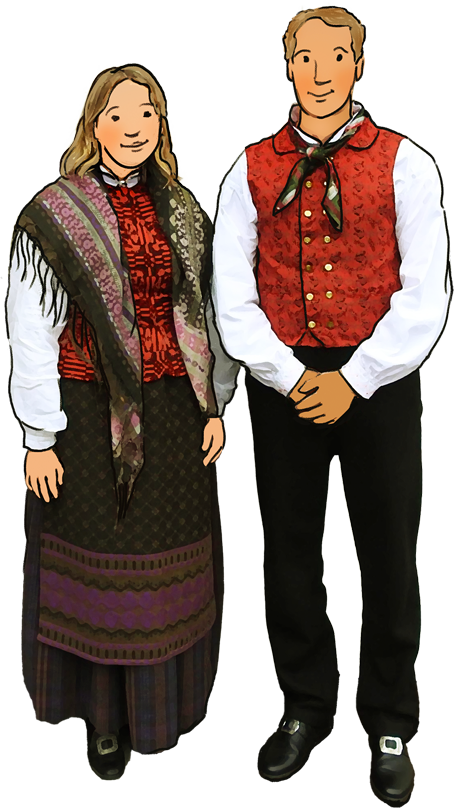
Women – Category 3
Much research went into the reconstructed bunads from Selbu, the area where many of Sons of Norway’s founders were born. A committee of four women tackled the reconstruction, drawing on preserved clothing swatches from the area. This bunad is an ode to the regional tradition of weaving, as it is the beautiful woven patterns rather than silver or embroidery that steal the show. Archival materials and photos of 1870-80s clothing were pored over and a reconstructed women’s bunad was created from the 1950s to 1977
The plaid skirt, damask-woven apron, jacket and shawl are all based on a navy blue and violet color scheme, with hints of earth tones. The skirt was patterned after a bridal skirt in which the bride had dyed and spun all of the wool herself, before weaving the fabric. In contrast, the vest is a bright red cloth with a black block-printed pattern. The hat is this bunad’s only embroidered article- if you are married, it’s more typical to wear an unembellished black cap.
Men – Category 3
The men’s bunad came out in 2007, after many years of research and compilation by the Bunadsnemda i Selbu. The men’s costume includes black pants, a navy wool jacket with brass buttons, a bright red and black vest with brass buttons and a neck scarf to top it off.
Sources:
Gudbrandsdalen
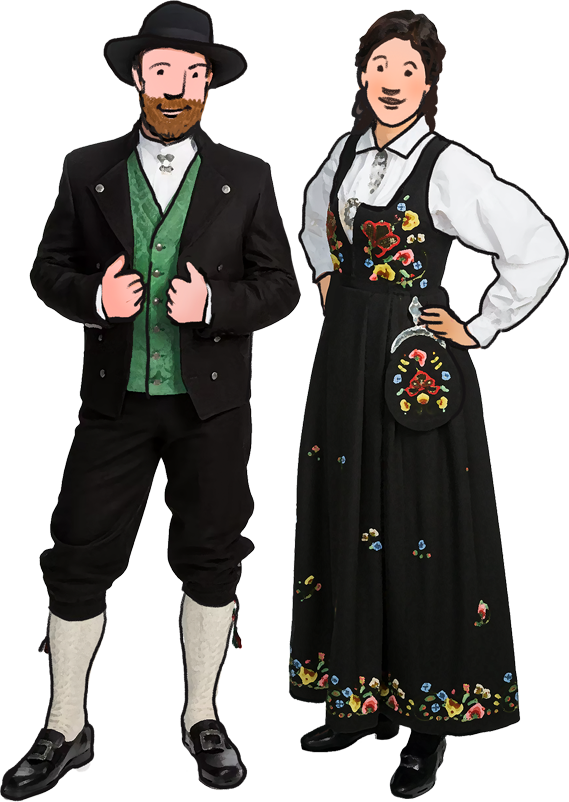
Women – Category 5
The festbunad from Gudbrandsdalen (the Gudbrand Valley) was a collaboration in the 1910s by a trio with ties to the theater. Norske Teatret (Norwegian Theater) founder Hulda Garborg, a writer and dramatist also known for her work to promote bunad culture, tailor Anna Gjermine Nilsen and her artist/designer husband Axel Waldemar Johannessen worked together to create this bunad. The latter two creators had been deeply involved with theatrical costuming and pivoted to launch their own bunad workshop.
Embroidered skirts had been popular in the early 1800s, and source garments from the area inspired the festbunad (formal bunad) from Gudbrandsdal. The cut of this garment with the bodice attached to the skirt with local embroidery embellishing each piece became a template for bunads created in other regions. The wool costume is typically black or navy wool with embroidered flowers of wool and metallic thread. The optional apron was originally silk, but after World War II, imported materials were hard to source, so aprons were switched to wool, and eventually omitted completely. A silver-clasped purse and optional cap are also richly decorated with embroidery. The silver jewelry known as draktsølv was an investment that was easy to transport and served the double-purpose of showing one’s affluence when going to church.
Men – Category 4
The men’s bunad from Gudbrandsdal was created in 1962 based on materials from the late 1800s. Men can choose from three double-breasted vest designs and various materials, from brocade to red plaid wool, and a back panel of a more breathable linen blend. The men’s pants may be woolen nikkers (knickers) with sock ties or long pants, and the black or white wool jacket can be short or long. It’s common to wear a black wool hat and natural off-white wool socks with this bunad. Silver cufflinks, a sølje neck pin and matching silver buttons polish off this smart costume.
Sources:
- https://snl.no/Gudbrandsdalens_festbunad
- https://snl.no/drakts%C3%B8lv
- http://folkcostume.blogspot.com/search?q=gudbrandsdal
- https://www.leopoldmuseum.org/en/exhibitions/32/aksel-waldemar-johannessen
- https://husflidengjoviklillehammer.no/gudbrandsdalens-festbunad
- https://www.norskebunader.no/nb/product/933/2030/gudbrandsdalsbunad
- https://www.solhjell.no/produkt/gudbrandsdal-mannsbunad-med-kort-jakke/
Graffer
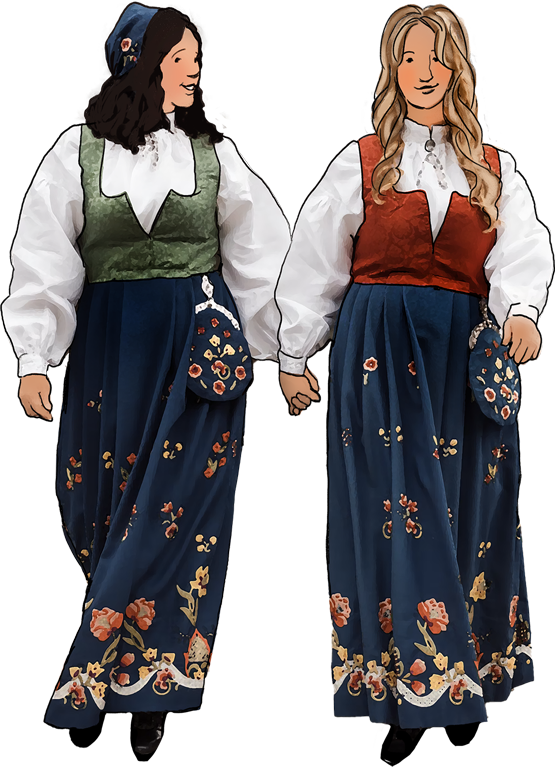
Women – Category 4
Another beautiful bunad from Gudbrandsdalen is the Graffer. Modeled in the 1930s after a 1700s dress discovered on the Graffer farm in Lom, the wool version is typically black, or navy wool with woolen and metallic embroidery on the bodice and skirt. After World War II, this bunad was also produced in white wool to a shortage of materials. Eventually, it transitioned into alternative options for the bodice in shiny red and green damask. The cap matches the color of the skirt and its embroidery.
As with anything homemade, the color selection and flower design may vary slightly based on the person who is sewing it.
Source:
Rondastakk
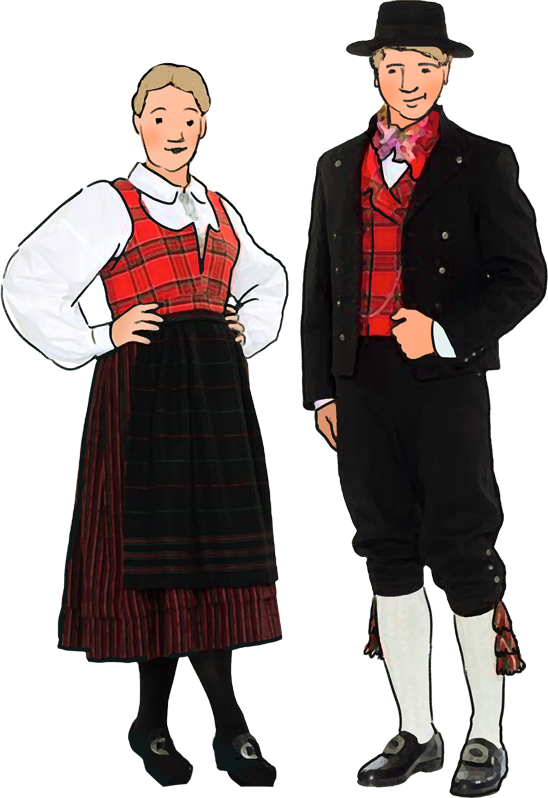
Women – Category 1
The Rondastakk/Råndastakk or “striped skirt” has been worn since the early 1800s in the northern Gudbrandsdal (Gudbrand Valley). This bunad sports some of the most varied textiles and colors- silk and wool appear in both damask and printed cloth, there is hand-woven wool cloth as well as embroidery on the apron. The length of the vertically striped skirt has varied over time, according to the trends of the day, or for work versus celebratory use. Typically, the apron is black, red or white wool ringed with cross-stitched patterns, and the bodice or can be monochromatic, damask, or most often appears as “rutaliv,” a bright red and green plaid.
Råndastakk is one of the few bunads that belongs to category 1, which means that it has been in uninterrupted use since girls and women wore this in their daily lives. Now this bunad is strictly worn for holidays and special occasions.
Men – Category 1
For a description of the men’s bunad that matches råndastakk med rutaliv, see the description of the men’s bunad from Gudbrandsdal.
Sources:
Sunnmøre
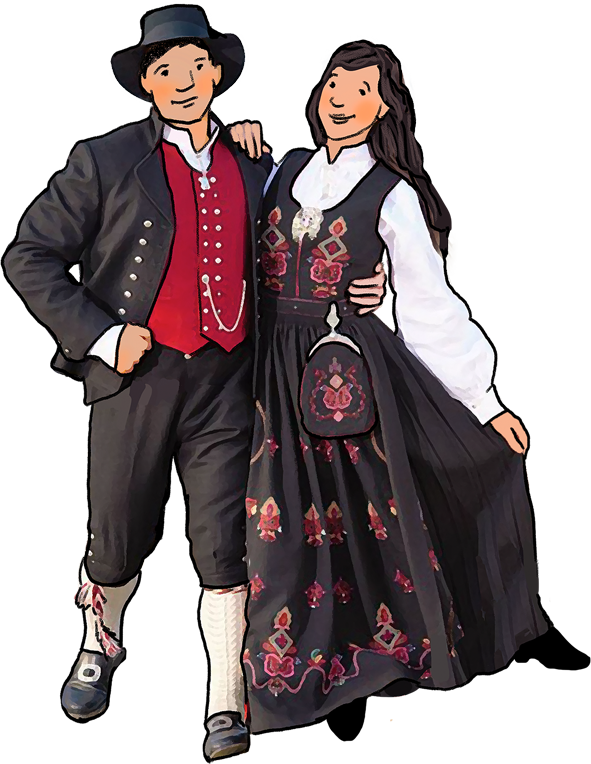
Women – Category 5
The Sunnmørsbunad or Ørskogsbunad is in the free design category, meaning that it was not an exact copy of a previous garment, but inspired by previous regional textiles, in this case an apron from Gjære gaard. There are actually 10 bunad variants from Sunnmøre whose designs started percolating in the early 1900s. Hulda Garborg helped the process along by publishing an embroidery pattern in color, to embellish a black or navy woolen bodice and skirt.
Garborg later visited the area and discovered that embroiderers had taken significant liberties with the colors and patterns. These eventually became standardized into distinct embroidery designs from Ørskog (I and II), Stranda, Skodje, Sykkylven (I and II), Hjo/rundfjord and Norddal. The Ørskogbunad was also given as a wedding gift to Crown Princess Märtha in 1929, so it was dubbed Märthabunaden, which led to its increased popularity.
Topping the bunad are a wool bonnet cap in the same color as the skirt or a white headscarf fastened with a wide black bow. The scarf’s embroidery is colorful for unmarried and black for married women. A less subtle hint to discern someone’s relationship status is that red stockings mean unmarried and black signify married.
Men – Category 5
The men’s bunad based on archival garments from Stranda in Sunnmo/re [category 4] resembles other bunads that originated in the early 1900s. The black wool jacket modeled in the style of 1800s clothing has a standing collar and two rows of silver buttons. The double-breasted burgundy vest also features silver buttons. A later addition of ornate black and red embroidered suspenders keep the waistline secure. A black wide-brimmed hat or a red stocking cap with tassel completes the costume. After this bunad was presented at an exhibition in 1926, it immediately took off.
Sources:
- https://snl.no/Sunnm%C3%B8rsbunad_-_kvinne
- https://nationalclothing.org/europe/63-norway/175-how-to-wear-norwegian-female-sunnmorsbunad-%E2%80%93-bunad-from-sunnmore-region-of-norway.html
- https://www.heimenhusfliden.no/bunad/sunnmorsbunad_herre/
- https://www.solhjell.no/produkt/sunnmore-damebunad-svart-eller-morkebla/
Hallingdal
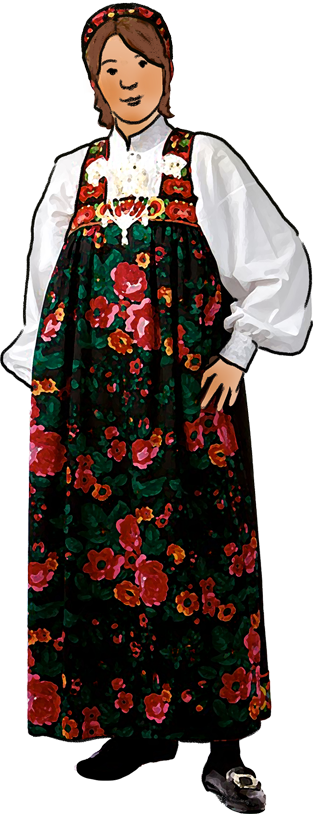
Women – Category 1
In Hallingdal, there are festbunads from Upper Hallingdal (Hol and Ål) and Lower Hallingdal (Hemsedal, Gol, Nes) which have the same high-waisted design stemming from the fashions of the late 18th and early 19th centuries. The dress is usually black wool with embroidery-rich straps, hem, breastband and back area. In Lower Hallingdal a vivid rose-printed apron is added, while the Upper Hallingdal version has either an understated black or striped apron. The empire waist design may appear to be a simple-to-make design, since a woman would rarely need to do alterations throughout her life. However, the rosesaum embroidery on this bunad, based on regional rosemaling, is extremely involved and almost covers the base fabric completely. The cap of black wool is embroidered to match the straps and hem. A short jacket is optional. The sølje in gold or silver incorporates dangling rings and filigree hearts. A jewelry piece unique to this region is a chain with dangling pendants that is pinned to the dress straps and hangs over the breastband.
Sources:
Sogn
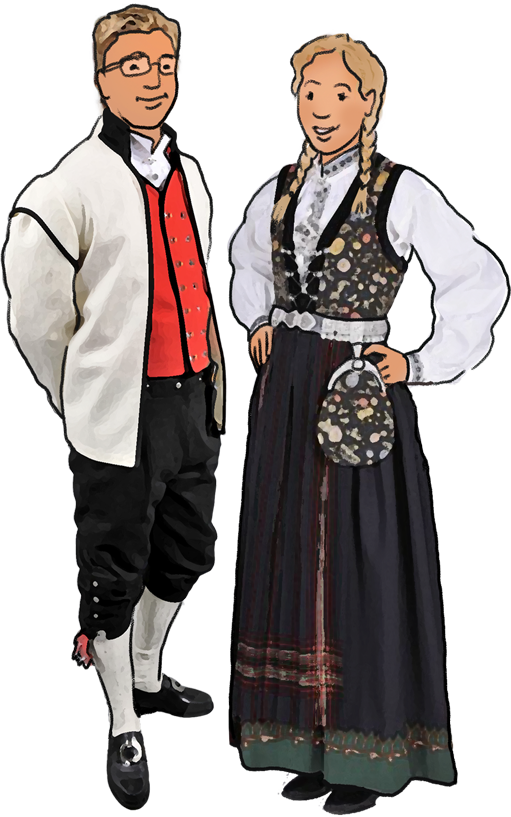
Women – Category 4
Preserved garment pieces from Sogn helped Anna Knudsen develop the women’s Inner Sogn bunad based on costume traditions from the 1800s, without adopting any pieces outright. Olga Berge later completed its look after WW II.
This version has a floral brocade bodice edged in black velvet with a silver eyelet and chain closure. Typical bodice colors are black, red and yellow. The black wool skirt is gathered or pleated with an appliqué band along the hem depicting the peaks and waves of Sogn’s fjords and coast. The wool-blend apron has vertical stripes which intersect with a broad band of stripes along the bottom hem. The white linen blouse typically has black embroidery along the collar, cuffs and placket.
Some accessories may be changed out to make the outfit more formal. A plastron can be inserted into the vest and worn with a matching bag. Unmarried girls and women traditionally wear a headband or kerchief. A married woman may choose to wear a pleated green silk over-blouse, a more elaborate headdress, and/or an elaborate silver-laden belt.
Men – Category 4
The men’s bunad from Sogn is a vibrant departure from the look of neighboring men’s predominantly black costumes. This 20th century creation was based on costume materials from the 19th century without drawing on a previous design. There are two color variations, both of which use black woolen knickers. The first style uses a white coat with black edging and a double-breasted red vest, while the other has a red coat with green edging and a single-breasted green vest. The cut of the coat draws on a Renaissance design. Both styles incorporate silver buttons and a sølje pin and white natural wool socks.
Sources:
Romerike
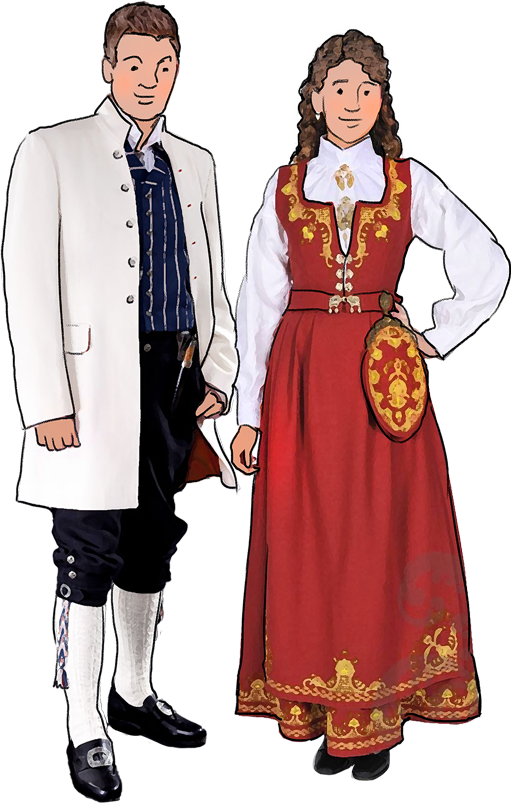
Women – Category 5
The women’s festbunad from Romerike comes in three colors of wool- blue, red and green. As a category 5 bunad, this design is completely or partially freely composed, but the golden embroidery happens to stem from an ornate pattern found on a horse blanket. There are three designs to choose from, called rather clinically L40, L46 and L55. The letter has no significance, but the number refers to the year that the design was produced. L40 has the same color skirt as bodice and the two garments are connected. Its embroidery was based on an attached pocket such as the one on a bunad. The patterns are made in three shades of yellow and one of red. In L46 the bodice is separate from the skirt and has a peplum, based on a sourced bodice from the region. The embroidery patterns differ slightly. L55 has a damask bodice of a contrasting color and different embroidery design. Each bunad is closed by three clasps and hooks which are oxidized silver or gold-plated. The apron and bag are similar to the skirt in color and embroidery.
Men – Category 5
Production for the men’s Romeriksbunad began in 1952 and it was designed by Åsmund Svinndal together with Oslo’s Heimen Husflid. The sources for the design were a shirt and vest found in Nannestad as well as an Aurskog painting dating to 1810. The balance of the garments were fashioned after local clothing traditions. The longer single-breasted white wadmal jacket is so local that the color of the buttonhole thread is an indication that it comes from Romerike. The pants are knickers-style with a silver-buttoned front flap closure. At the knee, there are both buttons and a silver buckle. The dark blue wool vest, fashioned after a vest found in Nannestad, is shorter in the front than the back. The vest has vertical stripes that appear white from afar, but a closer look reveals that they are yellow, burgundy, white and gray.
Sources:
Hardanger
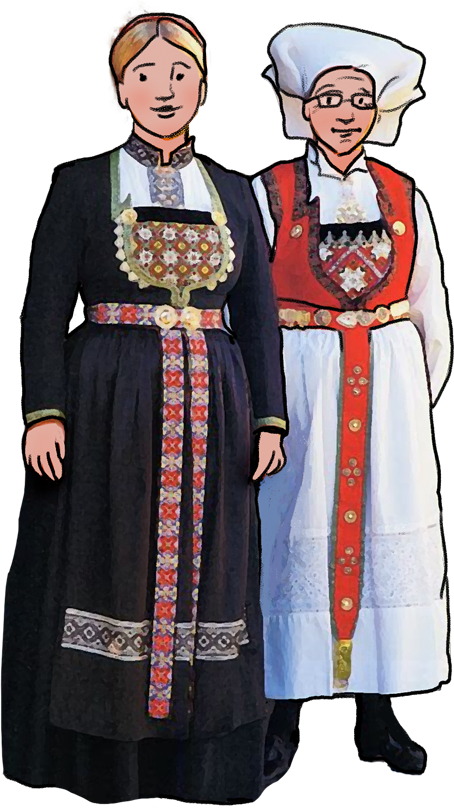
Women – Category 1
The iconic Hardanger bunad is perhaps the most well-known among women’s bunads. In this very traditional region, its use continued from daily wear into use as a bunad. Before other regions created their own bunads, it enjoyed a period of widespread use in Norway, becoming known as the National Bunad. The first Hardanger bunads were created in the mid-19th century in a variety of bodice colors, but now they are nearly always red. One reason that this bunad caught on was that Queen Maud was photographed while wearing one. The Hardanger bunad is not one single costume but several variants from the villages of the region. The two costumes shown here are from the village of Kvam.
Two hallmarks of the Hardanger bunad are the beaded and embroidered bringeduk, a plastron/square breast panel that is inserted into the vest, as well as the white apron with a lower border featuring hardangersaum embroidery. The cuffs and collar of the blouse may also feature this fine Hardanger lace. The belt for unmarried women is hand-beaded and matches the plastron. There are various patterns to choose for the plastron and apron motifs.
Married women may wear a silver-studded belt with a fangebelte or “lap belt” that hangs down over their apron. Unmarried women wear no headgear or a hairband. The woman in red wears a skaut, a white cotton cloth that is wet-starched into tiny pleats. Once the pleats set, the fabric is rolled to create the dramatic volume of the skaut.
The winter bunad, at left, is usually black with a long-sleeved wool jacket trimmed with green, rather than a vest. The black skirt is pleated, with stripes of velvet near the hem. The black apron has a band of white cross-stitch, and the white blouse has accents of black cross-stitch featuring symbols such as the eight-pointed rose. The plastron also features embroidery rather than beading.
Sources:
Oslo
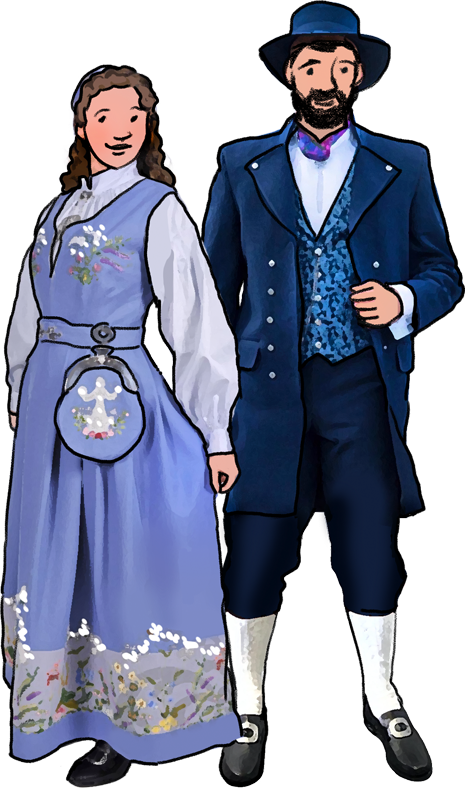
Women – Category 5
The structure of the women’s Oslo bunad is similar to the Gudbrandsdal festdrakt, with a classic livkjole, where the bodice is attached directly to the skirt. The Oslo bunad offers the color choice of light with a wide gray band along the hem, or dark blue, both featuring embroidered wildflowers that grow along the Akerselva (Aker River) from Maridalen to the Oslofjord. The bag/pocket has an embroidered coat of arms of St. Halvard, the capital’s patron saint. This bunad was made without historical basis by Steen and Strøm department store in 1947, to celebrate their sesquicentennial. The blouse for this bunad may be white or gray, and also features floral embroidery on the collar and cuffs.
Men – Category 5
It wasn’t until 1997 that the Oslobunad for men was produced. The longer coat is made of dark blue wool and has silver buttons that match the women’s bunad jewelry. The vest is sewn in silk brocade in either light and dark blue, or dark blue and red. The men’s costume also includes silver cufflinks and a sølje pin at the collar of the white linen shirt. Dark blue pants are secured with suspenders and a silk scarf is tucked inside the shirt collar. A wide-brimmed black hat completes this sharp bunad.
Sources:
Vestfold
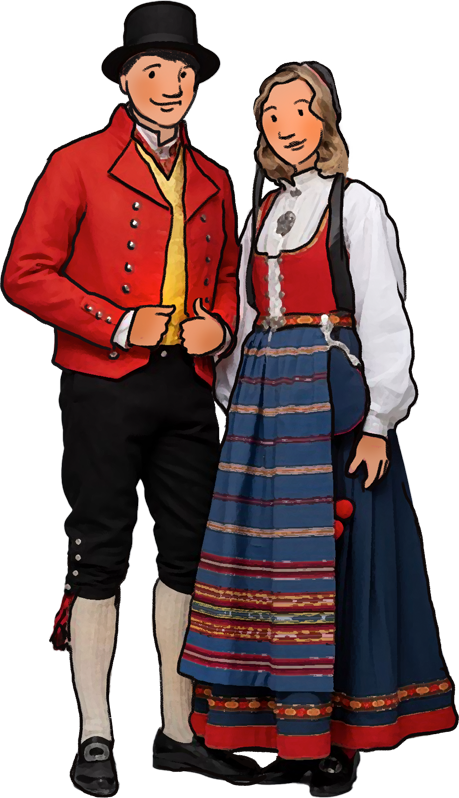
Women – Category 4
Vestfold is located west of the Oslo fjord and because of its proximity to Oslo, may have had fashion influences from far-flung places. There are several men’s and women’s bunads from this area, but we will only cover the two pictured here.
Ragnar Nordby, who worked with bunads his whole life, created men’s and women’s designs to represent Vestfold. As part of his studies, he developed the women’s bunad shown here, known as the “Vestfoldbunad from 1956.“ This was an adaptation of the 1932 model and features several woven elements. This colorful bunad can have a red or green wadmal bodice, edged with hand-woven trim and a black or pink silk damask cap trimmed with white lace. The horizontally-striped woven apron was fashioned after a photo from the 1890s, and can have stripes of varying frequency, color and width. The black wool apron strings end in whimsical red pompoms. The pleated skirt can be black or blue, and is edged with the same hue as the bodice. The woven belt matches the trim on the vest.
Men – Category 3
In Vestfold there are two men’s bunad variants: the first with a red wool jacket (rød trøye) and a gold silk brocade vest, which has gone through many revisions since its creation in 1930. It was modeled after a groom's vest from 1832. The source of the red jacket was a garment from Trolldalen in Andebu which Ragnar Nordby donated to the Norsk Folkemuseum in 1929.
The black wool knickers and jacket and vest have silver button closures, though the jacket is never actually buttoned. The hat used with this bunad is a departure from the wider brimmed hats common elsewhere. This one resembles a top hat, with its narrower brim and taller domed top. This style of hat was popular all over Norway in the early 1800s.
Sources:
Aust-Telemark
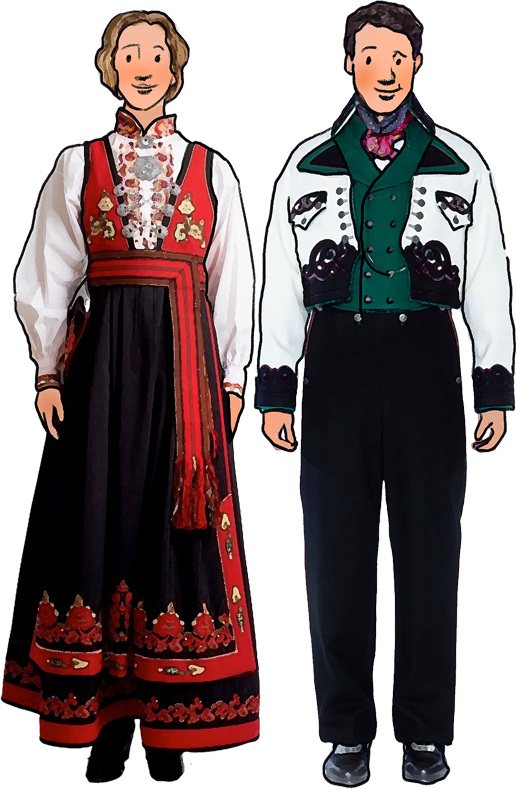
Women – Category 4
East Telemark’s women’s bunad med rødtrøye (with a red jacket) was a co-production between bunad committees in Telemark and Oslo. The design is a continuation of the work by Anne Bamle, who did research at the Norwegian Folk Museum on old Telemark drakt pieces and brought back some old patterns. The style is based on clothing customs in the region between 1820 and 1850.
The wide multi-colored brikkevev belt is wrapped around two or three times before being tied with the ends hanging down to the side opposite the purse.
and rich rosemaling embroidery on the blouse, apron and livkjole make this bunad distinctive. The bodice is bright red and the black or green skirt and apron are trimmed with a red stripe along the hem. Historically the very short bodice gave this bunad an empire waist, but gradually the bodice become elongated and the belt sits just above the waist.
For headpieces, women can weave or vippe their hair into a wreath shape using a long woven band (also called vippe). Wearing a silk scarf with or without a white kerchief is also an option.
The silver is typically gilded and filigree-style, and the brooches do not tend to have dangling pendants.
Men – Category 2
The men’s bunad from East Telemark, referred to as A94, was reconstructed in 1994 by Heimen and modeled after a coat found at a tailor’s workshop. Like the women’s bunad, this costume also stems from the mid-1800s and although it is mainly white, dark green and black, it is called the “gray jacket” bunad (gråtrøya/gråkufte) due to the unbleached natural wool color.
The single or double-breasted vest is dark green or black with ornate silver buttons. The short-waisted white or green jacket is embellished with black swirling appliqués top-stitched with white and red thread. The high-waisted black pants require suspenders to stay up and may be knickers or long pants with red and green piping. Similar to the women’s blouse, the men’s collar and cuffs are richly embroidered with multiple thread colors. A silk scarf may also be worn outside of the collar, along with a silver filigree pin.
Wool socks that accompany the knickers may be cable-knitted in natural white wool or ornate black and white tvibandsokk, two-strand socks. Either multi-color woven sock bands or leather straps can secure the socks. The hat can be a black/white knitted hat to match the socks, or a black felt hat.
Sources:
- https://snl.no/Aust-Telemarksbunad_med_gr%C3%A5tr%C3%B8ye
- https://emblabunader.no/produkt/damebunad/ost-telemark-2/
- https://www.heimenhusfliden.no/bunad/aust-telemark-a94/
- https://www.norskebunader.no/en/product/949/2035/ost-telemarksbunad
- https://www.heimenhusfliden.no/bunad/aust-telemark-a94/
- https://www.norskebunader.no/en/product/949/2035/ost-telemarksbunad
Aust-Agder
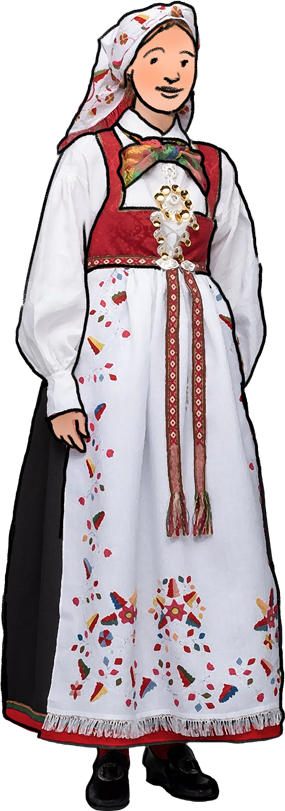
Women – Category 4
Aust Agder (East Agder) has several bunads- the one represented here is the Åmli-bunad which is also called the Aust-Agder bunad. It is based on preserved garments from the early 1800s, period paintings and written sources from the villages in Åmli parish but uses some creative license in the design. This bunad originated in the 1920s and was a product of local bunad committee as well as individuals who put it together. The bodice has long straps and a higher empire waist and can be made of silk, wool or blended fabric, edged with woven ribbon along the edges. The back of the bodice is accented with wide silver ribbon.
The woolen skirt features gathers in back and pleats on the sides. Along the hem, a wide green border is flanked by two narrower red edges. The belt can be either woven with a silver buckle and the belt ends hanging down in front of the apron, or it can be a gold-plated silver belt. =
One departure from the painted images is that the fringed skaut (headscarf) is now fastened behind the head, rather than under the chin.
The embroidery on the apron and headscarf was sourced from various source garments. Wearers may express their individuality by choosing different fabrics and colors for the bodice, apron and neckscarf.
Jewelry pieces include a brooch, søljer, belt clasp and chain that is laced through ornate eyelets for the front bodice closure.
Sources:
Setesdal
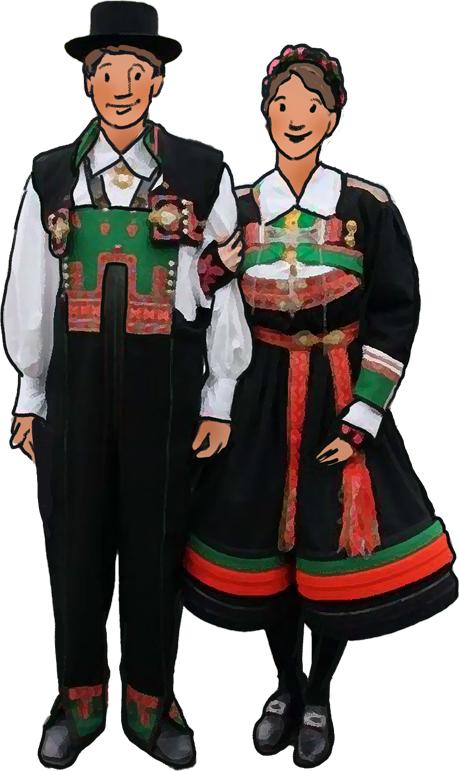
Women – Category 1
The tradition-rich valley Setesdal in Agder county can claim one of the oldest bunads in Norway. It is one of the areas that maintained uninterrupted use between folk clothing to bunad use. Because there was no gap in garment usage or knowledge, the Setesdal costumes have more nuances, with extra finery for formal occasions, and more distinctions for age, season and community status. For the most part, modern bunads are what used to be known as “church clothes.” Because of its longevity, the bunad is highly recognized outside of the area.
The bodice and knee-length skirt are called opplut in local dialect, and are sewn together. The bunad is actually made up of two skirts, a white underskirt and a more formal black skirt which is worn over top. Both skirts have a skore at the bottom which is a stiffened edge- this edge is red and green on the outer skirt, and black on the white skirt. The straps on the bodice are heavily ornament with embroidery that can be freely improvised by the maker, although there are also patterns available.
A black fringed headscarf is worn with a woven headband and may have a printed or embroidered rose pattern, that is tied above the forehead. Black stockings are typical, and there are two belt options: a multi-colored woven belt with a silver or gold clasp, or a leather belt with or without gold sølje-laden links.
Setesdal has a strong silversmith tradition and this costume incorporates ornate silver in its cufflinks, buttons, belk buckle and sølje brooches.
The shape of the Setesdal bunad dates back to medieval times and possibly earlier. The choice of colors has changed over time based on what was fashionable and available. Fine aprons with Hardanger lace used to be shown off as a status symbol, but now they are usually omitted on formal occasions.
Men – Category 1
While the women’s bunad shape stayed fairly constant, there was more modification to the men’s look. The high-waisted men’s pants debuted in the 19th century, taking over from roomy knickers. A unique feature of the pants is that they have a leather seat patch and other leather accents. Leather suspenders are buttoned to the highly decorated green and red bib, and the hem of the pant legs are also trimmed with red and green.
No amount of effort or fine material is spared on embellishment in the Setesdal men’s bunad. Possibly the most brilliantly colorful and detailed costume, it features as much embroidery as the women’s garments, if not more.
Men can wear two jackets with their bunad- either a knitted sweater in the famous black and white Setesdal lusekofte style, or a short wool jacket. Hats in this region are black wool in a variety of shapes, with the option of a white or red hatband.
Sources:
- https://snl.no/Setesdalsbunad_-_kvinne
- https://thornews.com/2014/05/14/female-bunad-from-setesdal/
- https://snl.no/Setesdalsbunad_-_mann
- http://folkcostume.blogspot.com/2017/12/costume-and-embroidery-of-setesdal-east.html
- http://www.lailanc.net/bunads/images/setesdal2.JPG
- https://i.pinimg.com/564x/23/ac/80/23ac80322417b549a4209edaa359014b.jpg
- https://i.pinimg.com/564x/bf/ce/25/bfce25596ee0e278f5e761e003c9f59d.jpg
- https://www.pinterest.com/pin/561331541049561563/
Rogaland
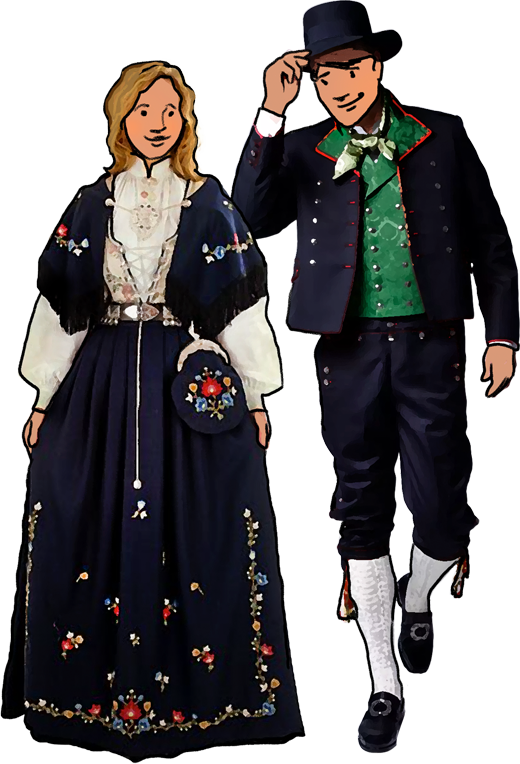
Women – Category 4
In the early 1900s, teacher Magnus Våge traveled around in Rogaland to document folk costumes from the region. Preserved costume pieces from the Stavanger Museum and his field research helped inform a picture of clothing traditions from the 1800s. With Magnus’ designs Borghild Våge constructed the first Rogalandsbunad in 1929.
The women’s bunad allows the wearer to choose from different fabrics and embroidery styles, collected from area villages. The bodice is typically a brocade or silk damask, and can either attach directly to the skirt, or have a peplum waist that lays over the skirt’s waist. The wool skirt colors are either blue, black or green.
The embroidery styles are named after the villages where they were found: Erfjord, Tjelmeland, Bokn, Løland, Jelsa, Frafjord and Bjerkreim. One style of embroidery is chosen and then applied to the cap, apron shawl and purse.
The bunadsølv or silver elements are søljer pins of varying sizes, embellished eyelets on the vest and a silver chain, along with a belt clasp, shawl holder and purse closure.
Men – Category 4
Men from Rogaland can choose from two bunad variants. The one pictured here was created in the 1920s based on archival garments, by Magnus Våge. Våge was an avid folk dancer and at the time only dancers wore bunads. These days, anyone can wear a bunad, regardless of their status or ability to dance.
Similar to the women’s bodice, the double-breasted men’s vest is made with a brocade or silk damask material, often in a floral pattern. The jacket and knickers are black wool edged with red piping. The jacket’s lapels have the same fabric as the vest. Buttonholes are stitched in contrasting red thread and the buttons are patterned silver.
The linen shirt’s standing collar is fastened with a silver pin and it is optional to tie a silk scarf over the collar. To finish off the costume, suspenders and sock bands are a must.
Sources:
